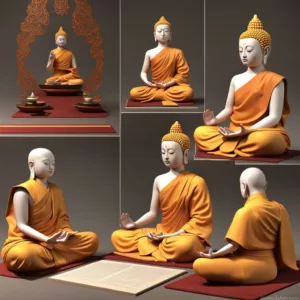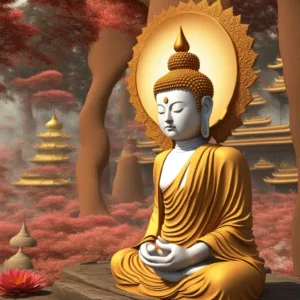
Dukkha, in Buddhism, means suffering. It is the first teaching of the Four Noble Truths. Suffering, if a being exists, is inevitable.
For ease, I use the categorization of dukkha into 3 categories.
- Dukkha as Dukkha (inherent suffering): This refers to the inherent dissatisfaction woven into the fabric of existence. Impermanence (anicca) and the inability to control things lead to a sense of unease, even in moments of pleasure.
- Dukkha as Viparinama (suffering from change): This aspect of Dukkha highlights the suffering caused by change and impermanence. Pleasant experiences eventually fade, leading to a sense of loss. Unpleasant experiences arise unexpectedly, causing pain and disruption.
- Dukkha as Sankhara (suffering from compounded existence): This refers to the suffering that arises from clinging and craving. We crave pleasure, security, and a sense of permanence, but these desires often lead to disappointment and frustration when they aren’t fulfilled. Our attachment to impermanent things and the illusion of a self fuels this cycle of suffering.
Secrets of Meditation for Anxiety
Like millions of people, you may have suffered from anxiety for years. Meditation, yoga, peaceful music – it never works. It takes too long, and it’s not stable. Why? Because peace is treated as a cause for freedom, but it’s not – it’s the result. The cause to free yourself from anxiety is completely different.
Click now to Overcome Anxiety for good.
Table of Contents
Dukkha Summary
| Aspect | Description |
|---|---|
| Central Concept | Dukkha (Suffering) |
| Context | Buddhist Philosophy |
| Related Concepts | Buddhism (Theravada, Mahayana), Four Noble Truths, Anicca (Impermanence), Anatta (Non-Self), Nirvana (Enlightenment), Karma, Rebirth (samsara) |
| Definition | Pali term translating to suffering, dissatisfaction, unease, or stress. A fundamental aspect of the human experience according to Buddhism. |
| Explanation | * Not just physical pain, but a broader spectrum of negative experiences (mental, emotional) * Arises from clinging to impermanent things (anicca) and the illusion of a permanent self (anatta) * First of the Four Noble Truths |
| Significance | * Driving force behind the cycle of rebirth (samsara) * Understanding its causes leads to liberation and Nirvana (freedom from suffering) |
| Additional Notes | * Different interpretations within Buddhism (Theravada – inherent nature of existence as Dukkha, Mahayana – possibility of joy within suffering) * Not nihilism – acknowledges suffering but offers a path to liberation |
| Further Exploration | * Books and articles on Buddhist philosophy and the Four Noble Truths * Buddhist meditation retreats or classes * Websites of Theravada and Mahayana Buddhist traditions |
How to meditate like a yogi
and enter profound samadhi
1. Introduction: The Inevitability of Suffering
Life throws us curveballs. We experience loss, heartbreak, and moments of physical pain. It’s undeniable – suffering is a part of the human experience. But have you ever wondered why it feels like there’s an undercurrent of unease, a sense of something missing, even in the good times?
Buddhism offers a profound concept to understand this deeper sense of dissatisfaction: Dukkha (pronounced doo-kha). It goes beyond just physical pain. Dukkha refers to a broader spectrum of suffering, including mental and emotional unease, dissatisfaction, and a sense of things never being quite right. Understanding Dukkha is the first step on the Buddhist path to liberation, a path that promises freedom from this pervasive feeling.
2. Beyond Physical Pain: The Many Faces of Dukkha
We often think of suffering as purely physical – a throbbing headache, a scrape on the knee. But Dukkha is a multifaceted gem, each facet reflecting a different aspect of our struggle. It encompasses the mental and emotional anguish we all experience at some point.
Imagine that constant chatter of worry in your mind before a big presentation. That’s Dukkha. Or the hollow feeling that creeps in despite your achievements, like you’re constantly chasing something just out of reach. That’s Dukkha too. The frustration of a relationship that’s lost its spark? You guessed it – Dukkha.
Dukkha can also manifest as a constant sense of lack, a yearning for something more. We chase pleasure, security, or external validation, but these things are fleeting. When they inevitably fade, we’re left feeling empty. By recognizing the many faces of Dukkha in our daily lives, we can begin to understand its root cause and find a way to move beyond it.



3. The Root Cause of Suffering: Clinging and Impermanence
Imagine life as a rushing river. The water keeps flowing, constantly changing, carrying everything with it. This impermanence, this ever-changing nature of things, is what Buddhism calls Anicca. People, experiences, even our own feelings – nothing stays the same forever.
So, where does suffering come in? We suffer because we often try to hold onto things as if they were fixed and permanent. We cling to possessions that eventually break or become outdated. We desperately hold onto relationships that have run their course.
Even more fundamentally, we cling to the illusion of a permanent, unchanging self (Anatta). We believe there’s a solid “me” that needs to be protected and fulfilled. But according to Buddhism, this self is an illusion, a constantly shifting collection of thoughts, feelings, and experiences.
Clinging to these impermanent things creates a constant struggle. It’s like trying to grab water from a rushing river – the tighter you clench your fist, the more water slips through your fingers. The more we cling, the more we suffer when things inevitably change or disappear.
4. The Four Noble Truths: Understanding the Path to Liberation
The Buddha, after his enlightenment, laid out the Four Noble Truths as the foundation of his teachings. These truths offer a roadmap for understanding and overcoming suffering.
The first Noble Truth is the one we’ve been exploring: The truth of suffering (Dukkha). We all experience suffering in various forms, and acknowledging this is the first step towards liberation.
The remaining three Noble Truths offer a way out of this cycle of suffering:
- The truth of the cause of suffering (Samudaya): This truth identifies the root cause of suffering as clinging and craving.
- The truth of the end of suffering (Nirodha): There is a way to end this cycle of suffering and achieve lasting peace. This state of liberation is called Nirvana.
- The truth of the path to the end of suffering (Magga): This truth outlines the Eightfold Path, a practical framework for Buddhist practice that helps us overcome suffering and achieve liberation.
By understanding these truths, we can begin to let go of clinging and cultivate a more accepting and peaceful way of living.
5. Overcoming Suffering: Detachment and the Path to Liberation
Understanding Dukkha isn’t just about recognizing suffering; it’s about finding a way out. By acknowledging the impermanence of things and the futility of clinging, we can begin to loosen our grip and cultivate a sense of detachment. This doesn’t mean becoming emotionless robots, but rather developing a healthy distance from the highs and lows of life.
Here’s where Buddhist practices come in. Meditation, a cornerstone of Buddhist practice, is a powerful tool for cultivating detachment and inner peace. Through meditation, we learn to observe our thoughts and feelings without judgment, allowing them to come and go like passing clouds. This practice helps us loosen the hold of cravings and attachments, reducing the suffering they cause.
The ultimate goal of the Buddhist path is Nirvana, a state of complete liberation from suffering. It’s not a place you travel to, but rather a state of lasting peace, free from the anxieties and desires that fuel Dukkha.
Tibetan for Dukkha
In Tibetan, Dukkha is translated as སྡུག་བསྔལ་ (sdug bsngal) (pronounced soo-doo ben-gal).
Here’s a breakdown of the word:
- སྡུག (sdug) – meaning suffering, pain, or misery
- བསྔལ་ (bsngal) – meaning trouble, distress, or affliction
The combined word སྡུག་བསྔལ་ (sdug bsngal) effectively captures the essence of Dukkha, which refers to the inherent dissatisfaction and suffering that permeates life according to Buddhist teachings.
Sanskrit for Dukkha
The Sanskrit word for Dukkha is दुःख (duḥkha).
Here’s a breakdown of the word:
- दुः (duḥ): This prefix can have various meanings depending on the context, but in this case, it translates to “bad,” “ill,” “unpleasant,” or “difficult.”
- ख (kha): This root word means “cavity” or “hollow.” Figuratively, it can also refer to a sense of lack or emptiness.
Therefore, दुःख (duḥkha) literally translates to something like “bad cavity” or “ill ease.” However, in the context of Buddhism, it has come to represent the broader concept of suffering, dissatisfaction, and unease that is inherent in human existence.
6. Conclusion: Beyond Suffering – A Path to Peace
Dukkha, the ever-present reality of suffering, may seem daunting at first. However, understanding its nature and root causes empowers us to break free from its cycle. By letting go of clinging and cultivating detachment through practices like meditation, we can navigate life’s challenges with greater equanimity and inner peace.
Buddhism isn’t just a philosophy; it’s a practical guide for living a more mindful and fulfilling life. Whether you’re a seasoned practitioner or simply curious, exploring Buddhist teachings and practices can offer valuable tools for overcoming suffering and finding lasting peace. Remember, the journey itself is a form of liberation, a continuous process of self-discovery and growth. So, take a deep breath, acknowledge the presence of Dukkha in your life, and embark on this path towards a more peaceful and liberated way of being.

May all beings be happy
May all beings be peaceful
May all beings be safe
May all beings awaken to the light of their true nature
May all beings be free







